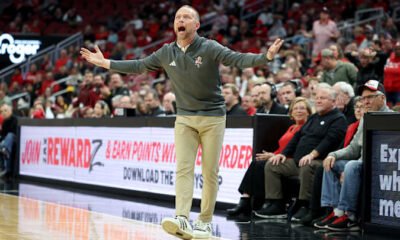Blog
Rick Carlisle’s coaching prowess was on full display in Game 3 of the NBA Finals, as he crafted a balanced effort that propelled the Pacers to a 116-107 victory. His belief in the bench was a game changer. Bennedict Mathurin and T.J. McConnell scored 37 points together, with McConnell recording five steals and five assists, becoming the first reserve to do so in a Finals game. Carlisle stressed team depth, ensuring that Indiana’s second unit outscored Oklahoma City’s bench 48–19. His defensive tweaks were also important. He rotated defenders on Shai Gilgeous-Alexander, providing full-court pressure that held the MVP to only three fourth-quarter points. His message following the game was clear: “This is the type of squad we are. We need everyone. “This is how we have to do it.” Carlisle’s ability to exploit his roster’s strengths and alter mid-game proved why he’s one of the greatest in the business
In Game 3 of the NBA Finals, Rick Carlisle put on a coaching masterclass that not only reignited the Indiana Pacers’ championship hopes but also reaffirmed his standing as one of the NBA’s elite tacticians. Indiana’s 116-107 victory over the Oklahoma City Thunder wasn’t just a product of star power or sheer offensive output—it was the result of meticulous preparation, bold in-game adjustments, and a deep trust in every player on the roster.
From the opening tip, it was evident that Carlisle had made adjustments specifically designed to disrupt Oklahoma City’s rhythm, particularly their MVP-caliber leader, Shai Gilgeous-Alexander. But the game’s defining narrative wasn’t about Indiana’s stars. It was about the bench, the unsung heroes who Carlisle empowered with purpose and responsibility. That trust paid massive dividends, swinging momentum and shifting the tone of the series.
Carlisle’s decision to expand the bench’s role in such a critical game was a calculated risk. With the series tied 1-1, the Pacers were under pressure to protect home court. Most coaches might lean heavily on their starters in such moments, but Carlisle zagged where others would zig. He unleashed reserves Bennedict Mathurin and T.J. McConnell early and often, and the pair rewarded his faith by combining for 37 points—nearly a third of the team’s total output.
McConnell, in particular, etched his name into NBA Finals history by becoming the first reserve to log five steals and five assists in a Finals game. His energy was infectious, his defensive intensity unrelenting. Time and again, McConnell applied full-court pressure on Oklahoma City’s ball handlers, disrupting their rhythm and forcing hurried possessions. His presence was the embodiment of Carlisle’s message: relentless effort, every possession, from every player.
“People talk about stars winning championships,” Carlisle said after the game. “But it’s team depth that gets you there. That’s how we have to do it. This is the type of squad we are. We need everyone.”
Those words weren’t just coach-speak; they reflected a core coaching philosophy. Carlisle has long been known as a maestro of in-game adjustments and rotational creativity. In Game 3, he utilized that reputation to its fullest, orchestrating a second unit that outscored Oklahoma City’s bench 48–19. In a game where the starters mostly traded even blows, it was this margin that decided the outcome.
Mathurin’s performance stood out not just for the numbers—19 points on efficient shooting—but for the confidence with which he played. He attacked the rim, stretched the floor, and defended multiple positions. That kind of poise and productivity from a young player in a Finals setting is rare. But it also speaks volumes about the environment Carlisle has created in Indiana: one where preparation breeds confidence, and every player understands their moment might come at any time.
Perhaps even more impressive than Carlisle’s offensive trust was the defensive blueprint he implemented. Containing Shai Gilgeous-Alexander is never about stopping him entirely—few players in the league can even dream of doing that. But Carlisle’s strategy of rotating defenders and applying full-court pressure from the third quarter onward had a cumulative effect. By the time the fourth quarter rolled around, Gilgeous-Alexander looked visibly fatigued and managed only three points in the final frame.
Carlisle’s defensive switch-ups kept OKC guessing. One possession, it was Aaron Nesmith picking up Gilgeous-Alexander full court. The next, Andrew Nembhard and even McConnell took turns harassing the Thunder’s primary initiator. The plan was not only tactical—it was psychological. It disrupted OKC’s comfort zone and forced others to beat Indiana, which they couldn’t.
This ability to make effective mid-game tweaks is what separates good coaches from great ones. Carlisle saw what wasn’t working in the first half—when Gilgeous-Alexander had his way with single defenders—and corrected it immediately. The shift wasn’t drastic, but the timing was perfect, allowing Indiana to build and maintain a manageable lead in the final stretch.
Beyond the Xs and Os, Carlisle’s leadership is palpable. He isn’t a coach who dictates from a pedestal. He walks with his team, asks of them what he knows they can give, and demands accountability at every level. That approach has helped transform the Pacers into more than just a playoff team—they now look like legitimate contenders. And much of that transformation can be traced directly to Carlisle’s fingerprints.
Even as Haliburton, Turner, and Siakam played pivotal roles, the story of Game 3 is about a coach trusting his full roster to carry the weight. It was Carlisle’s belief in his players—not just his stars—that created the game’s decisive moments. He played McConnell extended minutes in a high-leverage scenario, not because he had no other options, but because he recognized McConnell’s impact beyond the box score.
What makes Carlisle’s coaching so effective is his ability to maximize his personnel while minimizing the opposition’s strengths. In Game 3, he knew Oklahoma City’s starters could go toe-to-toe with Indiana’s. So, he flipped the equation by dominating the bench minutes and stealing extra possessions with aggressive defensive play. It’s a classic example of out-coaching the opponent by manipulating the margins.
Carlisle also displayed a willingness to let the game breathe. He didn’t over-manage or call unnecessary timeouts in the fourth quarter when Oklahoma City tried to rally. Instead, he allowed his players—starters and reserves alike—to play through adversity. That decision proved crucial in building their confidence and trust in one another, a bond that only strengthens as the stakes rise.
With the win, Indiana now holds a 2-1 lead in the series, and momentum firmly resides in their favor. But as Carlisle knows better than anyone, series can change quickly. His focus after the game was already on the adjustments to come, the mental discipline required to close out strong, and the need to sustain the same all-hands-on-deck mentality.
“This is how we have to do it,” he reiterated. “We don’t have the luxury of relying on one guy. We’re built differently. And that’s a good thing.”
That identity—collective effort, defensive grit, and tactical execution—is now firmly stamped on these Pacers. It’s the product of Carlisle’s leadership, honed through years of playoff battles, championships, and the quiet grind of player development. In Game 3, that experience translated into one of the most balanced and strategically brilliant wins of his career.
As the series progresses, one thing is clear: if the Indiana Pacers are going to win their first NBA title, Rick Carlisle will be the architect behind every crucial moment. Game 3 was a blueprint of how to win not just with stars, but with belief, depth, and masterful coaching.
-

 Blog4 months ago
Blog4 months agoPat Kelsey sends a strong three-word fiery message to the Louisville basketball’s team after their Cardinals 14th win…
-

 Blog7 months ago
Blog7 months agoNetflix releases “The Underdog,” a much-anticipated documentary about Drew Brees. slated for publication on the 25th
-

 Blog4 months ago
Blog4 months agoMikaela Shiffrin responds to cross-country skier Jessie Diggins’ letter following her failure to secure a solitary podium finish at the FIS Nordic Worlds
-

 Blog2 months ago
Blog2 months agoBehind the Turns: Netflix’s Upcoming Documentary on Mikaela Shiffrin’s Fights, Fears, and Love
-

 Blog4 months ago
Blog4 months agoWomen’s Slalom Run 1 at the FIS Alpine Skiing World Cup: Are
-

 Blog4 months ago
Blog4 months agoLegacy Tour Led Zeppelin has officially confirmed their 2026 reunion tour, which will be their first extensive live performances since 2007. The “Led Zeppelin Legacy Tour 2026” will begin on June 10, 2026, at Los Angeles’ SoFi Stadium.
-

 Blog6 months ago
Blog6 months agoFederica Brignone: “I’m fine, but my return to skiing is far off.”
-

 Blog6 months ago
Blog6 months agoAlice Cooper: From Fragile Boy to Shock Rock Icon—Netflix Unmasks the Nightmare
